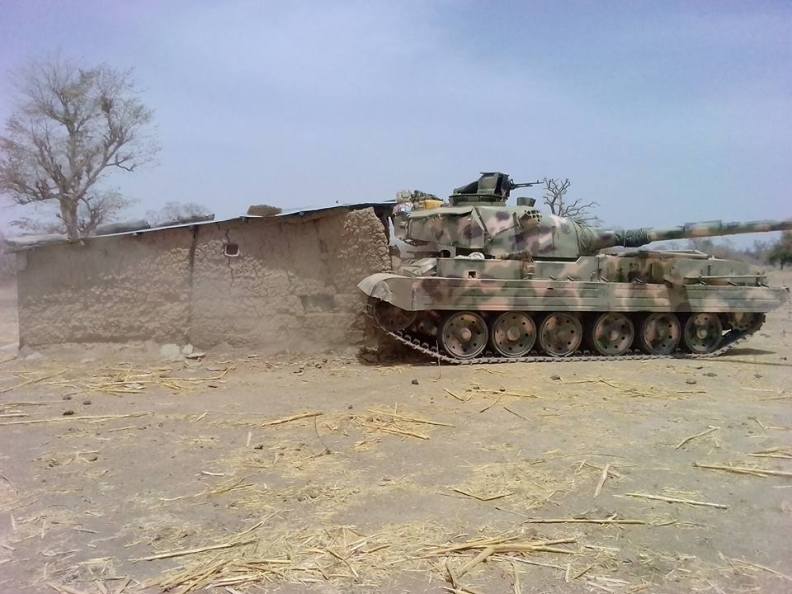Nigeria has fallen behind its potential adversaries in key capabilities and must do more to become a force to be reckoned with. We must come to terms with the fact that the security situation in the entire region has become volatile with different players with their divergent national interest.
In a continent where Russia, China, France, United States, Turkey are glamouring to have a foothold, the future may look very different in years to come. We have not been investing assets that will allow us face future threats should the unthinkable happens. We have not been investing in the equipment needed to bring the decade long insurgency to and end.
Nigeria has been under investing in combat amour and air defence capability for years. While armour is relevant, it must be capable. The Mk.3 Vickers, T-72M Main Battle Tanks, two of the key elements of the Nigerian army’s battle formation are obsolete. The Vickers have been in service since 1973.

The T-55 is even more obsolete. We applauded with enthusiasm the Federal governments decision to acquire new battle tanks in 2013 as long overdue. Nigeria still went cheap and acquired 77 obsolete T-72M tanks.
How can the T-72 M tank be obsolete?
The T-72M’s best known shortcoming is the inability to fire more than two rounds before breaking down. Soldiers complained the so called ”modernized” T-72 tank breaks down after two rounds are fired. Many have been abandoned on the battlefield or captured by Boko Haram fighters.
Nigeria’s fleet of tank was a potential adversaries worse nightmare in the 70s and 80s. But they are far past their prime. As it stands, these tanks do not scare potential adversaries like the Cameroonians or Chadians or even the French.
Aside from meeting the urgent operational requirements to counter improvised explosive devices in the northeast, many of these systems will likely not be replaced or upgraded to meet potential future threats from a near peer or capable adversary.
Efforts should be made to improve the situation acquiring more tracked reconnaissance vehicles, more advanced 8×8 mechanized infantry vehicles and more 155 self propelled artillery systems.
As Nigeria’s tank force has shrunken from nearly 350 state of the art tanks in the 70s and 80s, to a fleet of less than 200 today. When attrition rate is factored in Nigeria mighthave less than 100 tanks in operational condition.
The men and women who volunteer to keep us safe deserve to be given the best tools available to do their job with no compromise whatsoever. Nigeria faces a complex terrorist threat that has origins at home and abroad. We should be tired of 11 years of wars and focus on nation building and improving living standards. A decade of national development and prosperity has been stunted because of one security challenges or the other. Living standards have dropped exponentially and Africa’s richest country has become the poverty capital of the world. How can the governments lethargic approach to this war be tolerated?
Those who say modernizing the armed forces with state of the art weaponry are white elephant or prestige weapons that are not needed are making a terrible mistake. We now face an even more diverse range of security risks we have never had to contend with before, such as big power meddling in our affairs and the scramble for influence reminiscent of the colonial period.
We must shed our ”last minute buy it when you need it ”culture and tackle risks to our national security – taking a long term integrated approach both domestically and internationally, to identify risks early and treat the causes, rather than having to deal with the consequences.
With the powers that be deploying advanced weapons systems in West Africa and entering strategic partnerships with Nigeria’s ”historic” and ”potential” adversaries, the task of attaining air superior over an increasingly dangerous and unpredictable neighborhood falls on Nigeria’s tiny and obsolete fleet of just five F-7Ni fighter/interceptors.
Nigeria has historically relied on its fleet of 22 MiG-21 interceptors for strategic air defence. The MiG-21 is the fastest jet in the world. It was designed with one purpose in mind, to intercept hostile aircraft’s by its sheer speed and power.
With the end of military rule and a return to democracy, providing resources to maintain the nations armed forces was no longer a priority for Nigeria’s new civilian leaders. Nigeria faced no external or internal threat or so it was thought. Indeed the Obasanjo administration went a step further by cancelling planned acquisition projects.
In 2003 funding for the upgrading Nigeria’s fleet of 22 MiG-21 fighter interceptors was canceled. In 2005 Nigeria retired its obsolete fleet of MiG-21 fighters to make way for more modern aircrafts for air defense. After three years of indecision Nigeria eventually acquired 15 Chengdu F-7Ni Airguard interceptors from China, ostensibly as a stop gap measure, to fill the void in air defence left by the retirements of the MiG-21 in a $360 million deal.
In 2010 Federal governments air defence replacement program was cancelled, because they made the assumption that high end state on state conflict was a relic of the past. Nigeria faces no present or future threat to justify buying new combat aircrafts. However it is becoming increasingly apparent they were wrong. Nigeria needs a modern, large and powerful air force now more than ever.
With the region in chaos, where the powers that be are propping up the autocratic regimes of Nigeria’s historic and traditional enemies, Nigeria finds that it has to rely on its tiny fleet of just five F-7Ni fighters if the call comes to defend the nations airspace or establish a safe zone for Nigerian forces.
The F-7Ni is the only supersonic aircraft that Nigeria can rely on to take on and defeat enemy intrusion or carry out strategic strikes in contested environment. It is the only aircraft in the Nigerian Air Force inventory with air to air capability to defeat aircrafts like the MiG-29 Fulcrum and SU-25 fighters, both of which constitute the front-line aviation of Nigeria’s historic and traditional enemy.
But while it is important to have the right tool, more important is the human dimension. Pilots and maintainers must be trained and ready to defeat the highest end threats of they are to be sent into combat. There should be no compromise when it comes to providing the right tools to do the job. Pilots are expensive to train. Spending millions of dollars training a pilot only to assign them obsolete aircraft’s that are more likely to crash much less survive an air to air engagement is counter-productive and a waste of resources.
Before Boko Haram the F-7Ni was Nigeria’s dedicated air superiority fighter. While the rest of the airforce i.e Alpha jet trainers have been fighting low intensity counter insurgency wars. As an elite vanguard force, the F-7Ni fleet has focused exclusively on intercepting and defeating the highest end threat. Low intensity conflict is not the F-7Ni’s bread and butter.
The only way to protect Nigeria’s airspace against a potentially more powerful airforce will be to overwhelm the enemy with sheer numbers. We lost that capability with the loss of 18 Sepecat Jaguars and 22 MiG-21 fighters. Today less than five F-7Ni fighters can be scrambled and launched to intercept hostile aircrafts in Nigeria’s airspace, a far cry from the nearly 40 aircraft in the 80s.
It is not too late to redress this dangerous gap in Nigeria’s air defense capability. The acquisition of three JF-17 Multi-role fighters, while a welcome gesture bears little military significance. The JF-17 can only be in one place at the same time. You cannot provide strategic air defense and interdiction strikes with less than a Squadron of fighter interceptors.
The JF-17 It is a light weight single engine multi-role combat aircraft. It has seen active combat in Pakistan where it was used to bomb militant positions using both unguided and guided munitions for precision strike capability and has scored a kill when it shot down an Indian Air Force MiG-21 Bison.
It features a digital fly by wire system. It has beyond visual range capability with its Chinese PL-12 air to air missile. The PL-12 is an active radar guided beyond visual range air to air missile. It is comparable to the American AIM-120 or the Russian R-77 air to air missiles.
The full combat potential of the JF-17 is effectively negated by its limited. It is effectively almost useless because in a hypothetical war scenario any enemy airstrike will involve more than a dozen or more strike aircraft. The $630 million spent on 12 Super Tucano aircraft would have been better spent on a Squadron of JF-17 fighters.
The JF-17 fighter has all the capability of the Super Tucano and can still carry out interdiction missions. It can fight its way to a target or bug out of a high threat environment. With a top speed of Mach 1.6 the JF-17 can outrun a missile in some cases. The Super Tucano can do neither of these.
The JF-17 should be the backbone of the Nigerian Air Force with at least one or two Squadrons. It is very unfortunate that after spending nearly a billion dollars on aircraft acquisition the status quo has barely moved a needle. Nigeria’s air defense capability remain abysmally low.
The Super Tucano can only be used for specialized mission only in a permisive enviroment. Almost one BILLION DOLLARS spent yet Nigeria’s ability to defend its airspace or critical infrastructure should the need arise is virtually non-existent.
CONCLUSION
Nigeria should give the highest priority to bringing a quick end to this war. This entails rebuilding the air force, protecting our operational capabilities in high intensity conventional warfare, while also reviewing all our counter terrorism powers to ensure we retain only those that are necessary to protect the public.We must invest in capabilities to become more resilient both to external and internal threats.We must establish a transformative national program to end this decade long war of attrition and focus on nation building and improve the living standards of Nigerians.

